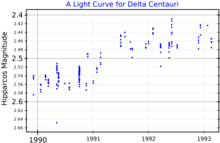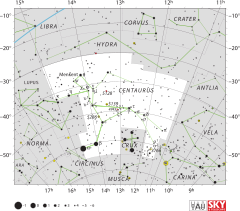Delta Centauri
| Observation data Epoch J2000 Equinox J2000 | |
|---|---|
| Constellation | Centaurus |
| Right ascension | 12h 08m 21.49764s[1] |
| Declination | −50° 43′ 20.7386″[1] |
| Apparent magnitude (V) | +2.57[2] (2.51 - 2.65[3]) |
| Characteristics | |
| Spectral type | B2Vne[4] or B2 IVne[5] |
| U−B color index | −0.92[2] |
| B−V color index | −0.13[2] |
| Variable type | γ Cas[3] |
| Astrometry | |
| Radial velocity (Rv) | +11[6] km/s |
| Proper motion (μ) | RA: −49.94[1] mas/yr Dec.: −7.19[1] mas/yr |
| Parallax (π) | 7.86 ± 0.47 mas[1] |
| Distance | 410 ± 20 ly (127 ± 8 pc) |
| Absolute magnitude (MV) | −2.94[7] |
| Details | |
| Mass | 8.7±0.3[4] M☉ |
| Radius | 6.5[8] R☉ |
| Luminosity | 5,129[4] L☉ |
| Surface gravity (log g) | 3.92[8] cgs |
| Temperature | 22,360[8] K |
| Rotational velocity (v sin i) | 263±14[9] km/s |
| Age | 21.5±1.5[10] Myr |
| Other designations | |
| Database references | |
| SIMBAD | data |
Delta Centauri, Latinized from δ Centauri, is a star in the southern constellation of Centaurus. The apparent visual magnitude of this star is +2.57,[2] making it readily visible to the naked eye. Based upon parallax measurements, it is located at a distance of about 410 light-years (130 parsecs) from the Earth.[1] The star is drifting further away with a radial velocity of +11 km/s.[6]
Properties[edit]

δ Centauri is a shell star, with a distinctive spectrum created by material thrown off into a disk by its rapid rotation. It is also a variable star whose brightness varies from magnitude +2.51 to +2.65. It has been classified as a γ Cassiopeiae type variable.[12] The energy from this star is being radiated at an effective temperature of over 22,000 K from the outer envelope, giving it the blue-white hue of a B-type star.[13] It has a radius of 6.5 times the radius of the Sun[8] and 8.7 times the Sun's mass.[8]
The stellar classification of this star is B2Vne,[4] which presents as a B-type main-sequence star. N. Houk in 1979 found a class of B2 IVne,[5] with the luminosity class of IV suggesting that this may be a subgiant star that has exhausted the hydrogen at its core and begun to evolve away from the main sequence. Detailed study of the spectrum suggests that the disparity is due to gravity darkening which makes the subgiant spectrum appear similar to a main-sequence star.[14] The star is spinning rapidly, with the resulting Doppler effect giving its spectrum broad absorption lines as indicated by the 'n'. The suffix 'e' means this is a classical Be star, which is a type of hot star that has not yet evolved into a supergiant and is surrounded by circumstellar gas. The presence of this gas creates an excess emission of infrared, along with emission lines in the star's spectrum. Most of it is concentrated around the equator, forming a disk.[8]
Some of the variation in this star may be explained by assuming it is a binary star system. This proposed secondary star would need to have about 4–7 times the Sun's mass and be orbiting with a period of at least 4.6 years at a minimum separation of 6.9 Astronomical Units.[12] δ Centauri shares a common proper motion with the nearby stars HD 105382 and HD 105383, so they may form a small cluster or perhaps a triple star system.[12] It is a proper motion member of the Lower Centaurus–Crux sub-group in the Scorpius–Centaurus OB association, the nearest such of association of co-moving massive stars to the Sun.[15]
Etymology[edit]
In Chinese, 馬尾 (Mǎ Wěi), meaning Horse's Tail, refers to an asterism consisting of δ Centauri, G Centauri and ρ Centauri.[16] Consequently, δ Centauri itself is known as 馬尾三 (Mǎ Wěi sān, English: the Third Star of Horse's Tail.).[17] From this Chinese name, the name Ma Wei appeared.[18]
The people of Aranda and Luritja tribe around Hermannsburg, Central Australia, named Iritjinga, "The Eagle-hawk", a quadrangular arrangement comprising this star, γ Cen (Muhlifain), γ Cru (Gacrux), and δ Cru (Imai).[19]
See also[edit]
References[edit]
- ^ a b c d e f van Leeuwen, F. (November 2007), "Validation of the new Hipparcos reduction", Astronomy and Astrophysics, 474 (2): 653–664, arXiv:0708.1752, Bibcode:2007A&A...474..653V, doi:10.1051/0004-6361:20078357, S2CID 18759600
- ^ a b c d Feinstein, A.; Marraco, H. G. (November 1979), "The photometric behavior of Be Stars", Astronomical Journal, 84: 1713–1725, Bibcode:1979AJ.....84.1713F, doi:10.1086/112600
- ^ a b Samus, N. N.; Durlevich, O. V.; et al. (2009). "VizieR Online Data Catalog: General Catalogue of Variable Stars (Samus+ 2007-2013)". VizieR On-line Data Catalog: B/GCVS. Originally Published in: 2009yCat....102025S. 1. Bibcode:2009yCat....102025S.
- ^ a b c d Levenhagen, R. S.; Leister, N. V. (2006). "Spectroscopic analysis of southern B and Be stars". Monthly Notices of the Royal Astronomical Society. 371 (1): 252–262. arXiv:astro-ph/0606149. Bibcode:2006MNRAS.371..252L. doi:10.1111/j.1365-2966.2006.10655.x. S2CID 16492030.
- ^ a b Houk, Nancy (1979), Michigan catalogue of two-dimensional spectral types for the HD stars, Ann Arbor, Michigan: Dept. of Astronomy, University of Michigan, Bibcode:1978mcts.book.....H
- ^ a b Evans, D. S. (June 20–24, 1966). "The Revision of the General Catalogue of Radial Velocities". In Batten, Alan Henry; Heard, John Frederick (eds.). Determination of Radial Velocities and their Applications, Proceedings from IAU Symposium no. 30. Determination of Radial Velocities and Their Applications. Vol. 30. University of Toronto: International Astronomical Union. p. 57. Bibcode:1967IAUS...30...57E.
- ^ Anderson, E.; Francis, Ch. (2012), "XHIP: An extended hipparcos compilation", Astronomy Letters, 38 (5): 331, arXiv:1108.4971, Bibcode:2012AstL...38..331A, doi:10.1134/S1063773712050015, S2CID 119257644.
- ^ a b c d e f Meilland, A.; et al. (October 2009), "VLTI/MIDI observations of 7 classical Be stars", Astronomy and Astrophysics, 505 (2): 687–693, arXiv:0908.1239, Bibcode:2009A&A...505..687M, doi:10.1051/0004-6361/200911960, S2CID 12694072
- ^ Frémat, Y.; Zorec, J.; Hubert, A.-M.; Floquet, M. (2005). "Effects of gravitational darkening on the determination of fundamental parameters in fast-rotating B-type stars". Astronomy and Astrophysics. 440 (1): 305–320. arXiv:astro-ph/0503381. Bibcode:2005A&A...440..305F. doi:10.1051/0004-6361:20042229. S2CID 19016751.
- ^ Tetzlaff, N.; Neuhäuser, R.; Hohle, M. M. (January 2011), "A catalogue of young runaway Hipparcos stars within 3 kpc from the Sun", Monthly Notices of the Royal Astronomical Society, 410 (1): 190–200, arXiv:1007.4883, Bibcode:2011MNRAS.410..190T, doi:10.1111/j.1365-2966.2010.17434.x, S2CID 118629873
- ^ "Hipparcos Tools Interactive Data Access". Hipparcos. ESA. Retrieved 8 December 2021.
- ^ a b c Meilland, A.; et al. (September 2008), "δ Centauri: a new binary Be star detected by VLTI/AMBER spectro-interferometry", Astronomy and Astrophysics, 488 (3): L67–L70, arXiv:0807.4622, Bibcode:2008A&A...488L..67M, doi:10.1051/0004-6361:200810624, S2CID 118737029
- ^ "The Colour of Stars", Australia Telescope, Outreach and Education, Commonwealth Scientific and Industrial Research Organisation, December 21, 2004, archived from the original on 2012-03-18, retrieved 2012-01-16
- ^ Meilland, A.; Millour, F.; Stee, Ph.; Spang, A.; Petrov, R.; Bonneau, D.; Perraut, K.; Massi, F. (2008). "δ Centauri: A new binary be star detected by VLTI/AMBER spectro-interferometry". Astronomy and Astrophysics. 488 (3): L67–L70. arXiv:0807.4622. Bibcode:2008A&A...488L..67M. doi:10.1051/0004-6361:200810624. S2CID 118737029.
- ^ de Geus, E. J.; de Zeeuw, P. T.; Lub, J. (June 1989), "Physical parameters of stars in the Scorpio-Centaurus OB association", Astronomy and Astrophysics, 216 (1–2): 44–61, Bibcode:1989A&A...216...44D
- ^ (in Chinese) 中國星座神話, written by 陳久金. Published by 台灣書房出版有限公司, 2005, ISBN 978-986-7332-25-7.
- ^ (in Chinese) AEEA (Activities of Exhibition and Education in Astronomy) 天文教育資訊網 2006 年 7 月 29 日
- ^ Richard Hinckley Allen: Star Names — Their Lore and Meaning: Centaurus
- ^ Raymond Haynes; Roslynn D. Haynes; David Malin; Richard McGee (1996). Explorers of the Southern Sky: A History of Australian Astronomy. Cambridge University Press. p. 8. ISBN 978-0-521-36575-8.

